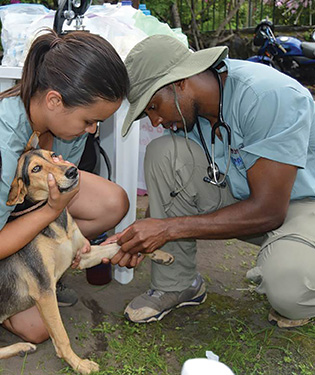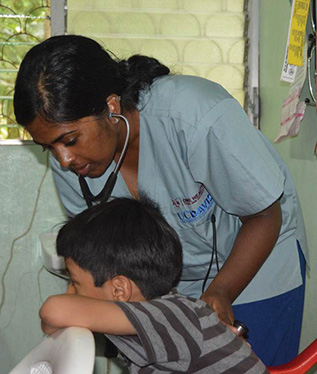One Healthy Village at a Time: Changes in Ometepe, Nicaragua
 Two volcanoes dominate the landscape of Ometepe, the largest island in the Lake of Nicaragua. Concepción, the active volcano in the northern part of the island, has a picturesque conical shape. The ash it generates during eruptions enriches the island’s soil, creating fertile farmland used for sustainable farming by Ometepe’s inhabitants. Maderas, its extinct counterpart to the south, is covered in a cloud forest and holds a lagoon in its center. Much of the land around Maderas is part of a nature reserve that is home to a wide array of plant and animal species.
Two volcanoes dominate the landscape of Ometepe, the largest island in the Lake of Nicaragua. Concepción, the active volcano in the northern part of the island, has a picturesque conical shape. The ash it generates during eruptions enriches the island’s soil, creating fertile farmland used for sustainable farming by Ometepe’s inhabitants. Maderas, its extinct counterpart to the south, is covered in a cloud forest and holds a lagoon in its center. Much of the land around Maderas is part of a nature reserve that is home to a wide array of plant and animal species.
Three core aspects of life on Ometepe–environment, animals, and people–were brought together by three Texas A&M University students this past summer as part of a four-week One Health project on the island. One Health is the collaborative effort of multiple disciplines working locally, nationally, and globally to attain sustainable optimal health for the ecosystem. These principles were put into practice by the members of the project in a variety of ways during their time in Nicaragua.
A sustainable project
 The multidisciplinary team included students and faculty members from Texas A&M and the University of California, Davis. Texas A&M was represented by students Christina Babu of the Texas A&M Health Science Center College of Medicine; Thomas Jeffreys of the Texas A&M School of Public Health, Department of Epidemiology and Biostatistics; and Ashton Richardson of the Texas A&M College of Veterinary Medicine & Biomedical Sciences (CVM); and Merrideth Holub, the program coordinator for the One Health Initiative in the CVM.
The multidisciplinary team included students and faculty members from Texas A&M and the University of California, Davis. Texas A&M was represented by students Christina Babu of the Texas A&M Health Science Center College of Medicine; Thomas Jeffreys of the Texas A&M School of Public Health, Department of Epidemiology and Biostatistics; and Ashton Richardson of the Texas A&M College of Veterinary Medicine & Biomedical Sciences (CVM); and Merrideth Holub, the program coordinator for the One Health Initiative in the CVM.
Prior to the trip, participants prepared at their respective schools. Four weeks of training included learning about zoonotic diseases, water treatment, animal handling, human vitals, and how to collaborate inter-professionally.
“Our curriculum these past four weeks has basically covered everything you would want to know pertaining to animals and humans,” said Richardson in an interview before the trip. “We’ve studied foodborne illnesses, human medicine, environmental topics, and even history lessons on Ometepe island. It’s really important to be culturally aware and respectful when you go into another country. This has honestly been the best learning experience that I’ve had; I’ve never had another experience where I went from vaccinating pigs to learning how to deliver a baby in the afternoon. It’s really kept us engaged and focused.”
Once in Nicaragua, the team began working toward the trip’s main objective: establishing a baseline knowledge of the Ometepe region on environmental, animal, and human issues from a One Health prospective.
“One of our main goals for this trip is to create a sustainable project that will continue after we leave,” said Babu prior to the trip. “We’re only there for four weeks, but we have so much to do. One of our main goals is to work with the resources that [the inhabitants] do have and not bring in things they normally don’t have access to. We hope to create something that’s lasting and can be maintained for future years of this project.”
Projects completed in pursuit of the objective included holding a public health fair; creating a sustainable kids’ cafe; working with local physicians, veterinarians, community leaders, and others to find solutions and strategies; and researching the needs of the community for future work toward creating One Healthy Village.
Project findings
 The students also worked in the clinics of Dr. Sara Gomez, a local veterinarian, and Dr. Sandra Villagra, a physician. Through work with animal and human patients, information for future work was gathered from human diagnostic data, physical exams of animals, and observations. Team members also used responses from a community based participatory research (CBPR) questionnaire to gather information on general household demographics, nutrition status, oral hygiene, human health, animal health, and environmental health.
The students also worked in the clinics of Dr. Sara Gomez, a local veterinarian, and Dr. Sandra Villagra, a physician. Through work with animal and human patients, information for future work was gathered from human diagnostic data, physical exams of animals, and observations. Team members also used responses from a community based participatory research (CBPR) questionnaire to gather information on general household demographics, nutrition status, oral hygiene, human health, animal health, and environmental health.
Data from a sample of 50 human residents of Ometepe who visited Dr. Villagra’s clinics revealed several areas that can be improved by future endeavors. Family histories indicated a prevalence of hypertension, diabetes, and cardiovascular disease. In addition, blood pressure measurements associated with prehypertension were observed in both male and female participants, and the average BMI was in the overweight range. Approximately one in four participants reported having joint or muscle pain.
The CBPR questionnaire, completed by 42 people, provided further insights on the status of public health on the island. Just over half of respondents reported losing a child. Of the 40 respondents who use water from a potable source, only two stated that they treat the water they collect. Over half of the respondents reported they did not have good dental health, and the most prevalent reason given was lack of money. Similarly, over half of the participants indicated they did not have a nutritious diet, with finances again given as the main reason. With regard to pediatric health in the community, 91 percent of respondents stated they are worried about a lack of medication. When medication is unavailable, the majority of the participants self-medicated or used medicinal plants and natural remedies. The questionnaire also revealed a discrepancy between the percentage of people with a family history of hypertension, 41 percent, and those who reported being concerned about the condition, 11 percent. This discrepancy suggests members of the community may not fully understand the serious effects of hypertension.
Information on animal health on the island was compiled from observations of physical exams by Dr. Gomez, which included exams of 31 dogs, 5 horses, 1 pig, and 1 cat, and responses to a questionnaire taken by 22 animal owners. Ninety percent of respondents reported their animals are allowed to roam freely, and 81 percent allow their animals to enter their homes. All horses examined had ticks and symptoms of internal parasites, and approximately one third of the dogs presented with ticks and fleas. Only five of the dogs had been spayed or neutered. Both large and small animals generally serve at least two purposes for their owners, including companionship, transportation, protection, pest control, and traction, for example pulling a cart. Although 90 percent of the chickens on the island are considered a food source, egg-collecting techniques used by their owners were found to be inefficient. Management practices observed on the island could pose a threat to animal health and, indirectly, the health of their human owners.
Moving forward
The data gathered by the team shows a clear need for future work on Ometepe. Projects that utilize the One Health concept of interconnections between human, animal, and environmental health, such as the sustainable cafe and community garden, allow the community to improve all three areas of life. For the students, being involved in a project that makes a positive impact in a community is its own reward.
“One Health is becoming such a hot topic these days, but not many people understand it fully,” said Richardson. “I’m hoping this program will shed a light on the importance of collaborating and how that approach is the best when we talk about education, development, or just helping people in general. I’m grateful for the opportunity to participate.”


